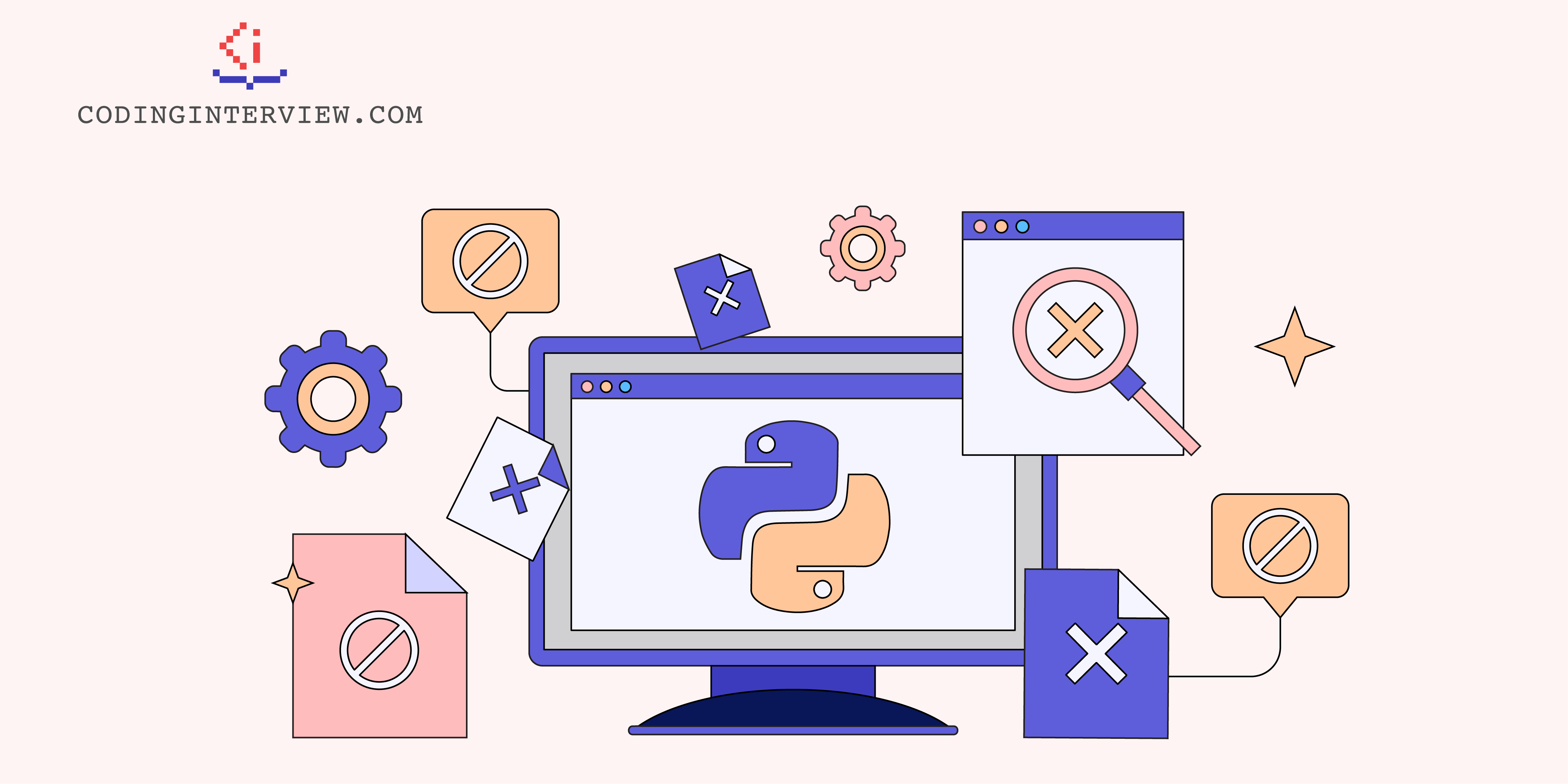Python officially turns 34 this month! Since its initial release by Guido van Rossum in 1991, Python has become one of the world’s most powerful, versatile, and widely used programming languages. Despite the emergence of new programming languages, Python maintains its relevance, consistently ranking among the top languages in industry surveys and developer preference lists. Its readability, simplicity, and extensive ecosystem have made it a favorite among developers across various domains, from web development and data science to artificial intelligence and automation. Python’s adaptability makes it ideal for beginners to learn programming easily while allowing experienced engineers to build scalable and efficient applications. For aspiring developers preparing for coding interviews, Python offers an intuitive syntax and a rich set of libraries that simplify problem-solving.
Why is Python a top choice for coding interviews?
Python is widely accepted in coding interviews across top tech companies, including Google, Meta, Amazon, and Microsoft. As Python is commonly used in backend development, machine learning, and automation, companies see it as a valuable skill for real-world software development.
So, what makes Python such a strong choice for coding interviews?
- Concise and readable syntax
- Rich standard library
- Strong support for data structures and algorithms
- Efficiency in solving algorithmic problems
Concise and readable syntax
Lower-level languages like C++ or Java often require lengthy implementations for simple tasks, whereas Python allows developers to write clean, readable code with fewer lines. As interviewers appreciate solutions that are easy to understand and Python’s syntax naturally promotes clarity and brevity, Python’s expressiveness plays a major advantage in coding interviews, where time is limited, and clarity is essential.
For example, a sorting algorithm requiring multiple lines in other languages can often be implemented in Python with a single built-in function (sorted()), allowing candidates to focus on solving the problem rather than dealing with boilerplate code.
Rich standard library
Python has a powerful standard library that reduces the need to implement low-level functionalities from scratch. Modules like math, itertools, and functools help solve complex computational problems more efficiently. Additionally, libraries such as NumPy and pandas provide tools for handling large datasets, which can be useful for technical assessments involving data analysis or system design. Even though most coding interviews focus on core algorithmic concepts, the availability of these libraries highlights Python’s versatility and makes it an attractive long-term choice for developers.
Strong support for data structures and algorithms
Python provides extensive built-in support for key data structures like lists, sets, dictionaries, and tuples. As coding interviews are constrained by time and many coding interview questions revolve around manipulating data structures, Python’s ease of use makes it possible to implement and test solutions rapidly. The collections and heapq modules also offer optimized implementations for queues, heaps, and other advanced data structures, making Python an excellent choice for algorithmic challenges.
Efficiency in solving algorithmic problems
When preparing for coding interviews, efficiency plays a crucial role in problem-solving. Python offers a range of built-in functions and optimizations that streamline the process, making writing clean and efficient code easier while improving execution speed. One of the most effective techniques in Python is using list comprehensions. Instead of iterating through lists with explicit loops, list comprehensions allow for concise and efficient data transformations. Lambda functions provide another way to enhance efficiency. These anonymous functions are useful for quick, in-line operations, especially when working with sorting, filtering, and mapping data. Python also provides built-in methods for sorting and searching, such as the sorted() function and the bisect module. Based on the Timsort algorithm, the built-in sorting function is optimized for performance and eliminates the need for manual implementations. The combination of concise syntax, memory-efficient processing, and optimized built-in functions makes Python an excellent choice for tackling searching, sorting, and recursion challenges.
The zen of Python
Python’s design is guided by 19 aphorisms known as The Zen of Python, which encapsulate the language’s core philosophy. These principles, written by Tim Peters, are not strict rules but rather a set of guiding thoughts that influence how Python is structured and how Pythonic code should be written. The principles are as follows:
- Beautiful is better than ugly: Code should be aesthetically pleasing and well-structured rather than cluttered and difficult to read. A well-organized codebase improves maintainability and collaboration.
- Explicit is better than implicit: Code should clearly state its purpose rather than relying on hidden behaviors or assumptions. A direct, self-explanatory approach makes debugging and collaboration easier.
- Simple is better than complex: Choose simple solutions whenever possible. Overengineering can make code harder to maintain and understand.
- Complex is better than complicated: While some problems require complex solutions, they should not be needlessly complicated. Complexity should serve a purpose, not make code harder to read.
- Flat is better than nested: Excessive nesting in code, such as deeply layered conditions or loops, reduces readability. Keeping a flat structure whenever possible makes code easier to follow.
- Sparse is better than dense: Avoid cramming too much logic into one place. Proper spacing and formatting improve clarity and prevent confusion.
- Readability counts: Python was designed to be readable and intuitive. Code should be written with future developers in mind, ensuring it is easy to understand and modify.
- Special cases aren’t special enough to break the rules: The language follows consistent principles, avoiding unnecessary exceptions to its design. This consistency makes Python predictable and reliable.
- Although practicality beats purity: While Python values clean code, there are situations where pragmatic solutions are necessary. Efficiency and real-world usability take priority over strict adherence to idealistic rules.
- Errors should never pass silently: Ignoring errors without handling them properly can lead to unexpected issues. Python encourages explicit error handling so that problems can be identified and fixed.
- Unless explicitly silenced: If an error must be ignored, it should be done intentionally and for a clear reason rather than silently dismissed.
- In the face of ambiguity, refuse the temptation to guess: If a piece of code is unclear or ambiguous, Python encourages seeking clarity rather than making assumptions. Well-defined logic leads to fewer unexpected errors.
- There should be one and preferably only one obvious way to do it: Python promotes having a single best way to solve a problem rather than multiple confusing approaches. A well-defined method makes the language easier to learn and use.
- Although that way may not be obvious at first unless you’re Dutch: A humorous reference to Python’s creator, Guido van Rossum, who is Dutch. It acknowledges that some design choices may take time to fully understand.
- Now is better than never: It’s better to start working on a solution today rather than endlessly delaying it for perfection. Progress is more valuable than waiting for the perfect moment.
- Although never is often better than right now: Immediate action is important; rushing into a solution without proper planning can cause long-term problems. Thoughtfulness and strategy are key.
- If the implementation is hard to explain, it’s a bad idea: A function or algorithm should be clear enough to be explained easily. If it’s too complicated to describe, it likely needs simplification or refactoring.
- If the implementation is easy to explain, it may be a good idea: Readable, well-structured solutions tend to be effective and maintainable, making them a preferred approach.
- Namespaces are one honking great idea, let’s do more of those: Namespaces help organize and separate code, preventing conflicts between variable names and improving modularity. They make large projects more manageable and scalable.
These principles shape the way Python is written, taught, and used. Following these guidelines helps developers write clean, maintainable, and efficient code.
Should you use Python for coding interviews?
Python is widely favored in coding interviews due to its simplicity, efficiency, and powerful built-in capabilities. The three ways Python gives an edge in technical assessments and why you as a developer should use Python for coding interviews are as follows:
Faster execution and debugging
Python is an interpreted language. This means it runs code line by line instead of requiring compilation before execution. As Python does not require a compilation step, candidates can quickly test and iterate on their code, making refining solutions and fixing errors easier. However, as Python does not require a compilation step, candidates can quickly test and iterate on their code. Unlike compiled languages, which report multiple errors at once after compilation, Python stops execution at the first encountered error. This makes debugging more structured, as errors can be addressed one at a time.
Flexibility in writing code
Python uses dynamic typing, which means developers do not need to explicitly declare variable types. Instead, the interpreter determines the data type at runtime. Candidates can write more concise and readable code without requiring explicit type declarations. Defining variables without specifying their type allows candidates to experiment with different approaches quickly. This is particularly useful when refining an algorithm or testing edge cases. As variables can change types dynamically, candidates can adapt their solutions without restructuring their code. For example, if needed, a variable initially holding a numerical value can later store a string or a list.
Built-in tools for efficient problem-solving
Python has a comprehensive standard library that provides pre-built functions and data structures. The collections module provides specialized data structures that extend Python’s built-in types. These structures offer more efficient ways to handle common tasks in coding problems, such as managing frequency counts, implementing queues, or storing key-value pairs. The heapq module is useful for solving problems that require priority queues, sorting, or heap-based algorithms. The functions module contains utilities for optimizing recursive solutions and functional programming techniques. As candidates do not need to implement commonly used functionalities from scratch, it saves their valuable time in an interview.
Final word
In coding interviews, every second counts, and Python’s simplicity, efficiency, and readability provide a distinct advantage. With built-in data structure manipulations, optimized performance tools, and a clean, structured syntax, Python allows candidates to focus on problem-solving rather than wrestling with implementation details. Python empowers interviewees to write concise, efficient solutions under pressure by reducing boilerplate code and enhancing clarity.


